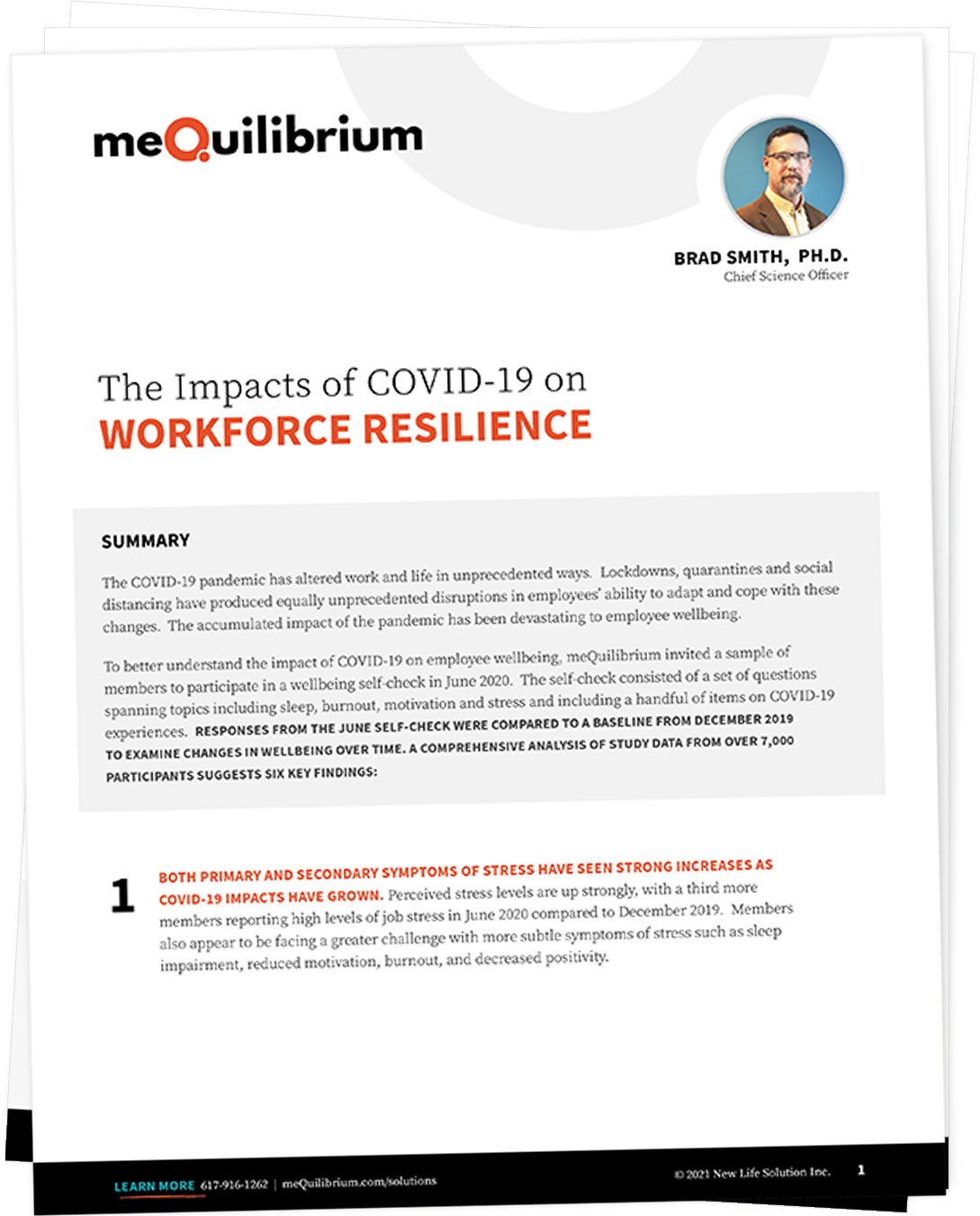Pandemic Fatigue: Mitigating Risks with Resilience
As the pandemic wears on, HR leaders must take even stronger actions to repair the damage made by the pandemic to their businesses and the well-being of their workforces.
As the pandemic wears on, HR leaders must take even stronger actions to repair the damage made by the pandemic to their businesses and the well-being of their workforces.
2020 reminds me of 9th grade: I survived, but given the choice to relive it: “No, thanks!” If you can imagine a highlights reel for last year, it might feature a global pandemic, widespread social unrest, political uncertainty, and massive economic instability, all of which combined to produce a level of turmoil that we have never before known. It is increasingly evident that a key byproduct of pandemic turmoil is, as the World Health Organization terms it, “pandemic fatigue.” Brought about by an extended period of emotional exhaustion and chronic disappointment, pandemic fatigue represents a real threat to both the physical and mental health of our workforce and, ultimately, to our economy. As the pandemic wears on, HR leaders must take even stronger actions to repair the damage made by the pandemic to their businesses and the well-being of their workforces.
The mental and physical effects of a year-long pandemic have taken a serious toll. I miss being able to travel to visit our customers, and to grab a non-virtual beer after work with our CTO to catch up on the crazy stuff that happens in any given week in a startup like ours. On a more serious note, like many of you, I’ve lost a family member to COVID-19. Given the widespread sense of loss we’re experiencing, meQuilibrium is checking in on our members periodically to help our employer customers know how best to help their workforces. In June 2020, we surveyed about 7,000 members and discovered that while there were serious threats to well-being due to the pandemic, resilient individuals were faring better than most. In December 2020 we checked in again with members for an update. We surveyed a total of just under 7500 members. The continued slide in well-being was astounding. In December of 2020, compared to June:
In the December check-in, we had the opportunity to dig a little deeper into the key drivers of the decline we are seeing among our members. The data suggest that the continued slide is driven —at least in part—by the additional responsibilities many of us have taken on at home.
Almost 1 in 5 members reported taking on a new caregiving role due to the pandemic. Women —already at the forefront of balancing work and family challenges—were 40% more likely than men to report taking on a new role as caregiver. Our data showed that these additional responsibilities have come with a significant cost. Among those who reported having taken on a new caregiver role, we found that typical declines in well-being were well in excess of the changes we noted in the non-caregiving population. Compared to those who had not taken on a new caregiving role, caregivers showed:
The continued slide in well-being observed in our member population also expresses itself in attitudes toward pandemic precautions. The more the pandemic wears on, the more physically and emotionally exhausted we become, and the more challenging it is to adhere to public health protocols, such as social distancing, mask-wearing, and proper hand hygiene. Data from our members revealed evidence of pandemic fatigue even as early as last Fall.
About 20% of our members who participated in an October 2020 study showed a high degree of fatigue with mask wearing, physical distancing and other pandemic precautions. Their responses indicated they were also more likely to put themselves and others at risk by traveling outside their local area for non-essential reasons. The more we let pandemic fatigue take over, the more risk we put on ourselves, on our communities, and on our organizations.
Should pandemic fatigue take hold more broadly we stand to reap its “rewards”: more unplanned absences, additional COVID-19 exposures in the workplace, continued shutdowns of work sites, and an even greater burden on working caregivers. In November of 2020 alone, there were 1.8 million unplanned absences in the US due to the increase in illness from COVID-19.
What then can HR leaders do to foster resilience at their own companies?
1. Model Critical Leadership Values. There are critical leadership values that boost resilience in organizations. Empathy, positivity, realistic optimism, transparency, and reinforcing self-care are all crucial to communicate to your workforce. Empathy has become extra important for those navigating the physical constraints of working remotely.
2. Reinforce the Three E’s. Your workforce will be less impacted by the current state of our pandemic if they can master the three Es: Emotion Control, Energy, and Engagement. In our recent study, members who showed the greatest improvements in each of these areas had markedly better well-being outcomes than members who showed little improvement.
3. Encourage Workforce Resilience Training. You can encourage your workforce to participate in resilience training. Even participating in just 3 minutes per day can have a major impact on an individual’s well-being. With meQuilibrium, we found that members who spent more time using our product were 49% less likely to suffer from the behavior aspects of pandemic fatigue.
While we may be closing in on the final chapters of the pandemic, these are easily the most important. The choices we make as individuals and as organizational leaders directly impact public health, workforce well-being, and ultimately the bottom line of every organization. Now is the time to be proactively addressing the challenges of your workforce brought upon by the pandemic.
Through the power of organizational resilience and people analytics, meQuilibrium helps HR leaders gain valuable insights into the thoughts, feelings and behaviors of the workforce. How? By leaning in to listen and drive the kinds of decisions that need to be made in order to support employees through all of life’s crises.
Download our whitepaper, “The Impacts of COVID-19 on Workforce Resilience” to get an in-depth understanding of the unique qualities of COVID-19 that have impacted the workforce and what you can do about it.

For more than 15 years, Dr. Brad Smith has been telling stories using health data. His career includes roles ranging from policy-focused work with the US Government Accountability Office to evaluation -related work for dozens of state, federal and private sector clients using health services research methods. He currently serves as Chief Science Officer at meQuilibrium, leading efforts to harness data to improve the product, enhance reporting to clients and establish the value proposition. He has served on the faculty of Drexel University and McDaniel College and is the author of more than 25 peer - reviewed articles on health and well-being.

Learn more about the top trends coming out of our recent research report from Chief Science Officer, Brad Smith, Ph.D.